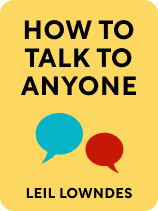

This article is an excerpt from the Shortform book guide to "How to Talk to Anyone" by Leil Lowndes. Shortform has the world's best summaries and analyses of books you should be reading.
Like this article? Sign up for a free trial here .
Do you find it difficult to make friends? What’s the key to making lots of friends?
According to communications expert Leil Lowndes, the key to making friends with anyone is to pretend that you’re already close friends. Pretending to like others feels so good that it eventually turns into genuine affection.
Here’s how to make more friends, according to Lowndes.
Pretend You’re Already Close Friends
In her book How to Talk to Anyone, communications expert Leil Lowndes explains how to make more friends. The key, she says, is to fake it till you make it. Pretend that you’re already close friends with the people you want to make friends with. She argues that you only feel—and broadcast—discomfort when you’re feeling unsure about how others will respond to you. However, when you imagine that you’re already close friends, you remove this uncertainty and automatically feel more relaxed and comfortable around others.
While you’re initially only pretending to like the person, you’re sending signals that put them at ease—encouraging them to like you and respond warmly to you. This makes you want to like them, resulting in a genuinely comfortable and enjoyable interaction.
2 Ways to Trick Yourself Into Sending Positive Signals
Many self-help practitioners mirror Lowndes’s suggestion that imagining the desired end result of your meeting—a close friendship—leads you to act in ways that bring it into reality. But, how can you make yourself believe that you’re friends with someone when you’re not? Self-help practitioners offer various ways to achieve this:
Joseph Murphy (The Power of Your Subconscious Mind) suggests that you should first consider how you’d like other people to think about you. Then think about them in this way, regardless of how they behave. For example, if you’d like people to compliment you, then think complimentary thoughts about others. Like Lowndes, Murphy argues that people will intuitively pick up on your positive thoughts and reflect them back to you.
Louise Hay (You Can Heal Your Life) suggests the inverse of Murphy’s approach: You need to think about yourself the way you want others to think about you. Hay claims that every experience in your life reflects your opinion of yourself: If you don’t like yourself, you send out emotional signals that make other people not want to like you. According to Hay, practicing positive affirmations will change the way you view yourself and the emotional signals that you send out. Other people will then reflect these emotional signals back to you. So, if you want others to like you, affirm to yourself, “I like myself” before approaching them.

———End of Preview———
Like what you just read? Read the rest of the world's best book summary and analysis of Leil Lowndes's "How to Talk to Anyone" at Shortform .
Here's what you'll find in our full How to Talk to Anyone summary :
- Practical techniques to help you overcome social discomfort
- How to confidently develop new connections
- How to appear more likable without saying a word






